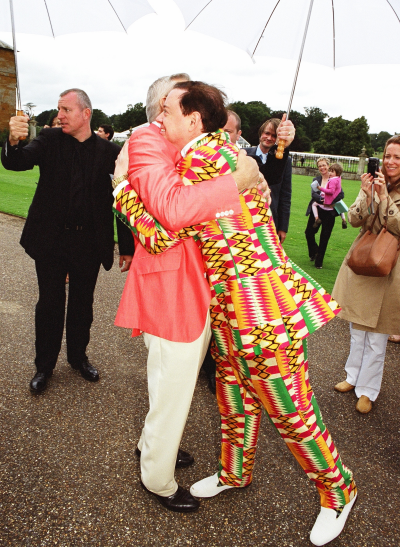
Andrew Solomon and John Habich, June 30, 2007. Photo: Hugo Burnand.
Thirteen years ago, I attended the glamorous wedding of a beloved friend, the writer Nana-Ama Danquah, in Ghana. Nana-Ama arranged for one of her chic cousins to escort foreign wedding guests to Accra’s best dealer in kente cloth, a modest storefront behind which we examined an array of colored fabrics that would put any rainbow to shame. One of the largest pieces of cloth, made of silk and cotton, was the one with colors that sang to me; at $2,000, it was also one of the most expensive. Pink, green, yellow, and white, it fairly glittered on the counter. It had come from the Akan people of the Ashanti Kingdom. I dithered briefly, solicited comments from the other wedding guests, then decided to go for it. I knew that it and I had a future together, though I didn’t yet know what it was.
My husband, John, and I married in 2007; the celebration spanned four days. I had had my London tailor make the kente cloth into a double-breasted suit that I wore for the end of the festivities. The tailor had been bemused but accommodating. I had told him to treat it like a pinstripe, match where he could, and cut it like my other suits. I didn’t mind when friends laughed, then came closer and observed the elegant lines of it. It was bold and exuberant, and I felt bold and exuberant about our gay wedding. John and I were celebrating not only each other but a dawning liberalism in which our love could be recognized and sanctified, and the kente-cloth suit felt to me like an optimistic way to return to the world. We had invited our friends to bring their children to the wedding, and they flocked to me in my kente. I felt like the Pied Piper.
John wore white flannel pants and a pink shantung blazer and pointed out that only with me could he be so attired and yet the peahen in the relationship.
I waited for another occasion for the suit and finally donned it again when I was cast in an Elton John video four years later. Now I visit it every day in my closet, where it puts all the khaki and gray flannel to shame, and I await its next outing. It’s seldom appropriate, but when it is, it sings for its supper.











